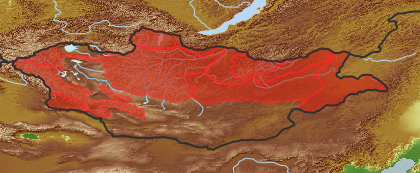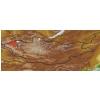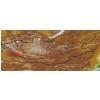| Class: | angiosperms |
| Order: | Myrtales |
| Family: | Onagraceae |
| Genus: | Chamaenerion |
| Scientific name: | Chamaenerion angustifolium (L.) Scop. |
| Name acc. to: | Gubanov 1996 |
| Herbar: | list records  |
| Synonym: | Epilobium angustifolium L. (acc. to Gubanov 1996) |
| open map in a new window |  |
| Habitat: | Pebbles at river banks, larch forests, birch kolki, forest fringes, clearings, fire sites, forest meadows, meadow slopes (Grubov 2001). |
| Habit (i)general appearance of a plant | |
| Growth form: (i)Herb, shrub, tree or climber. | herb (i)Herbaceous, erect plant, up to 2m high, mostly with a leafy shoot; if perennial, shoots die to the ground each season, shoots are not woody
example: Artemisia pectinata   inherited by family Onagraceae: herb inherited by family Onagraceae: herb
|
| Size of plant: (i)Attention: use flowering or fruiting specimens to assess plant height (many biennial plants possess only a basal rosette in the first year). | from 250 mm to 600 mm  inherited by genus Chamaenerion: inherited by genus Chamaenerion:
from 600 mm to 1000 mm  inherited by genus Chamaenerion: inherited by genus Chamaenerion:
|
| Parasite status: (i)Is the plant a half- or full parasite? | no parasite/saprophyte (i)Plant fully autonomous, leaves with chlorophyll
example: Most plants, Ranunculus  inherited by family Onagraceae: no parasite/saprophyte inherited by family Onagraceae: no parasite/saprophyte
|
| Water or terrestrial plant: (i)Where do the plants grow? | terrestrial (i)Plant grows on dry land
example: Orostachys spinosa  inherited by family Onagraceae: terrestrial inherited by family Onagraceae: terrestrial
|
| Leaf (i)expanded, usually photosynthetic organ of a plant (including phylloclades) | |
| Leaf development: (i)Structure and development of leaves. | with green leaves (i)Plant with green leaves  inherited by genus Chamaenerion: with green leaves inherited by genus Chamaenerion: with green leaves
|
| Leaf arrangement: (i)Arrangement of leaves at the stem. | alternate (i)One leaf per node; distiche: arranged in two vertical rows, equitant
example: Phragmites    inherited by genus Chamaenerion: alternate inherited by genus Chamaenerion: alternate
|
| Simple or divided leaves: (i)Are the leaves simple or completely divided in several parts? Blade of the leaf entire or (more or less) deeply dissected. Attention: There are various appearances of the leaf margin (from entire to toothed and lobed). Here, we ignore this and ask only for dissections that separate the leaf for more than one third of its length or width, whatever is smaller. Sometimes, it is difficult to tell apart compound leaves from a shoot system with simple leaves: look for stipulae and/or axillary buds at the ground of the leaves: if only some possess these structures, the others are most likely leaflets of a compound leaf. | simple (i)Non-divided leaf, but margin may be incised nearly to the ground   inherited by family Onagraceae: simple inherited by family Onagraceae: simple
|
| Shape of blade: (i)Easy for simple leaves. In compound leaves use the general shape of leaflet. Always check the ground for largest leaves of a plant. To be worked out: how to handle pinnate leaves? | elliptic (including ovate and obovate) (i)Elliptic: broadest at the middle and narrower at the two equal ends; ovate: egg-shaped, attached at the broad end; obovate: attached at the narrower end
example: Limosella aquatica   inherited by genus Chamaenerion: elliptic (including ovate and obovate) inherited by genus Chamaenerion: elliptic (including ovate and obovate)
linear incl.grasslike or oblong (i)Leaves more than two times longer than broad with more or less parallel margins; see character: stipule for ligula
example: Dracocephalum ruyschiana, Poaceae, Scutellaria scordifolia, Pinus   inherited by genus Chamaenerion: linear incl.grasslike or oblong inherited by genus Chamaenerion: linear incl.grasslike or oblong
|
| Petiole: (i)Leaf divided into stalk (petiole) and blade. | without (i)Leaves without petiole (stalk), sessile
example: Poaceae, Iris   inherited by genus Chamaenerion: without inherited by genus Chamaenerion: without
|
| Leaf colour upper side: (i)Shades of green on the leaf, upper side. | green (i)Clear green
example: Tribulus terrestris  inherited by genus Chamaenerion: green inherited by genus Chamaenerion: green
|
| Leaf colour lower side: (i)Shades of green on the leaf, lower side. | green (i)Clear green, in most species
example: Angelica decurrens  inherited by genus Chamaenerion: green inherited by genus Chamaenerion: green
|
| Leaf veination: (i)Arrangement of the main veins of a leaf. | pinnate (i)One main vein, several side veins, sometimes inconspicuous
example: Cicerbita     inherited by family Onagraceae: pinnate inherited by family Onagraceae: pinnate
|
| Flower (i)reproductive portion of the plant, consisting of sepals, petals, stamens, and pistils | |
| Flower appearance and pollination: (i)General appearance of the flower. | attractive, animal-pollinated (i)attractive and coloured flowers, mostly large, attracting surely animals
example: Trollius, Rosa, Chamaerhodos  inherited by family Onagraceae: attractive, animal-pollinated inherited by family Onagraceae: attractive, animal-pollinated
|
| Flower colour: (i)Attention: assess colour of the most colourful parts of the flower, but not of the stamens; be aware of single plants with a mutation (mostly white) on flower colour. | pink (i)Between red and white
example: Centaurium  inherited by genus Chamaenerion: pink inherited by genus Chamaenerion: pink
purple to violet (i)All colors between purple and violet, often changing with flower age
example: Pulmonaria  inherited by genus Chamaenerion: purple to violet inherited by genus Chamaenerion: purple to violet
|
| Perianth arrangement: (i)Attention: in some plants, flowers may be dimorphic in different ways (dioecious or gynodioecious). If flowers vary, record the characters of the most showy flowers. | double, different (i)Two types of perianth leaves, differently coloured (sepals: outer periant leaves, usually greenish, and petals: inner perianth leaves, usually coloured)
example: Parnassia    inherited by family Onagraceae: double, different inherited by family Onagraceae: double, different
|
| Flower symmetry: (i)Symmetry of the perianth leaves. Attention: to assess this character, look on sepals, petals and stamens, but neglect carpels and ovary. | radiary, regular (actinomorphic) (i)More than two axis of symmetry
example: Saxifraga: 5; Iris: 3   inherited by family Onagraceae: radiary, regular (actinomorphic) inherited by family Onagraceae: radiary, regular (actinomorphic)
zygomorphic (i)One axis of symmetry, monosymmetrical flowers
example: Pedicularis, Nepeta, Viola     inherited by genus Chamaenerion: zygomorphic inherited by genus Chamaenerion: zygomorphic
|
| Flower form: (i)common forms of flowers ? Veronica | simple (flat) - Do not confuse with inflorescences as in some Asteraceae (i)Petals spread out, flower appearing flat
example: Mollugo, Trientalis, Pulsatilla, Saxifraga   inherited by genus Chamaenerion: simple (flat) - Do not confuse with inflorescences as in some Asteraceae inherited by genus Chamaenerion: simple (flat) - Do not confuse with inflorescences as in some Asteraceae
|
| Sepal number: (i)Number of sepal leaves (outer perianth leaves, calyx leaves, mostly greenish). Attention, this character applies only for flowers separated in sepals and petals, thus excluding most monocots. Be aware of the bracts (involucral leaves) of Asteraceae flowerheads, do not qualify these as sepals! Be also aware in Rosaceae is often an epicalyx developed, in this case count all parts. | 4 (i)
example: Sinapis  inherited by genus Chamaenerion: 4 inherited by genus Chamaenerion: 4
|
| Petal / Tepal number: (i)Number of petal leaves (inner perianth leaves, usually coloured). | 4 (i)
example: Galium  inherited by genus Chamaenerion: 4 inherited by genus Chamaenerion: 4
|
| Spur: (i)A hollow, slender, sac-like appendage of the perianth leaves, storing nectar. | no spur (i)Flower without appendage
example: Peganum  inherited by family Onagraceae: no spur inherited by family Onagraceae: no spur
|
| Stamen number: (i)Attention: We ask for the reproductive organs of the flower dispersing pollen. Count only fully fertile stamens, not staminodia (e.g. Parnassia). | 7-9 (i)
example: Trientalis, Sedum  inherited by genus Chamaenerion: 7-9 inherited by genus Chamaenerion: 7-9
|
| Pistil number: (i)Number of pistils (female floral organs: style, if developed; stigma and carpels/ovary together build the pistil). | 1 (i)One carpel, but clearly one stigma
example: Pyrola, Primula, Alyssum  inherited by family Onagraceae: 1 inherited by family Onagraceae: 1
|
| Style number: (i)Portion of the pistil connecting the stigma to the ovary. | 1  inherited by genus Chamaenerion: 1 inherited by genus Chamaenerion: 1
|
| Stigma number per style: (i)Number of stigmas per style. | > 3 (i)More than three stigmas, resulting from more than three fused carpels with or without develped style  inherited by genus Chamaenerion: > 3 inherited by genus Chamaenerion: > 3
|
| Ovary position: (i)For entirely or partly fused carpels, describe their position in relation to the insertion point of perianth leaves (best done by doing a longitudinal section of a flower). | intermediate ovary (i)Ovary partly or fully underneath the perianth leaves, ovary not fused with axis but surrounded by a flower cup
example: Prunus, a lot of Rosaceae    inherited by family Onagraceae: intermediate ovary inherited by family Onagraceae: intermediate ovary
inferior (i)Ovary below the point where perianth leaves are inserted, always fused to an ovary
example: Vaccinum    inherited by family Onagraceae: inferior inherited by family Onagraceae: inferior
|
| Inflorescence (i)flowering part of a plant, describes the arrangement of the flowers on the flowering axis | |
| Inflorescence: (i)Structure of the inflorescence. | Flowers in inflorescence (i)No solitary flowers  inherited by genus Chamaenerion: Flowers in inflorescence inherited by genus Chamaenerion: Flowers in inflorescence
Simple inflorescences (i)Flowers sessile on a main shoot or on short to long not branched side shoots
example: Polygonum bistorta    inherited by genus Chamaenerion: Simple inflorescences inherited by genus Chamaenerion: Simple inflorescences
|
| Appearance: (i)Outer look of the inflorescence. | terminal (i)Inflorescence is the highest point of the plant and may consist of a single flower only
example: Cypripedium, Rhaponticum, Ligularia sibirica, Echinops  inherited by genus Chamaenerion: terminal inherited by genus Chamaenerion: terminal
|
| Inflorescence type: (i)Types of inflorescence. Attention: We here ask for the botanical nomenclature of inflorescences, which is sufficiently complicated. Tick only, if you are certain, or tick all inflorescence types that appear similar of these of the plant in question. | raceme (i)Stalked flowers arranged along a simple main axis, often one by one in the axils of leaves, maturing from bottom upwards
example: Aconitum barbatum   inherited by genus Chamaenerion: raceme inherited by genus Chamaenerion: raceme
|
| Fruit (i)the seed bearing organ, with or without adnate parts; a ripened ovary and any other structures which are attached and ripen with it. Aggregate fruits are handled like simple fruits for determination. | |
| Consistency: (i)Fleshy fruits or dry fruits, see dispersal adaptations for further classification. | dry (i)With a dry outer shell, no fleshy parts, but seed (embryo) could be edible  inherited by family Onagraceae: dry inherited by family Onagraceae: dry
|
| Type of fruit: (i)Common fruit types (including pseudocarp). | Solitary fruits (i)     inherited by genus Chamaenerion: Solitary fruits inherited by genus Chamaenerion: Solitary fruits
capsule (i)Dry dehiscent fruit, releasing seeds by slits or holes.
example: Poppy, most Caryophyllaceae, Cerastium, a lot of Scrophulariaceae, Iris (oppened capsule looks like Delphinium), Zygophyllum - it is a very common fruit type     inherited by genus Chamaenerion: capsule inherited by genus Chamaenerion: capsule
Dehiscent fruits (i)Fruits open along a longitudinale line (except silicula)  inherited by genus Chamaenerion: Dehiscent fruits inherited by genus Chamaenerion: Dehiscent fruits
|
| Opening of fruit: (i)Mode of dehiscence at maturity to release seeds. | opening along dehiscent line (i)Opening along a preformed line
example: Vicia, Lathyrus: pods  inherited by genus Chamaenerion: opening along dehiscent line inherited by genus Chamaenerion: opening along dehiscent line
opening / dehiscent (i)Dry? Fruits opening with different types  inherited by genus Chamaenerion: opening / dehiscent inherited by genus Chamaenerion: opening / dehiscent
|
| Seed number: (i)Estimate the number of seeds per fruit, if recognizable seeds are in the fruit (in rare cases a fruit may contain one seeded nuts: rose hip, carex). | 7-50 (i)Numerable, but may be counted
example: Vaccinum: multi-seeded berry, Ptilotrichum: few-seeded siliqua  inherited by genus Chamaenerion: 7-50 inherited by genus Chamaenerion: 7-50
|
| Root / shoot below ground (i)plant part below ground (in most cases), including below ground shoots, without leaves | |
| Root type: (i)Organisation of the roots. | allorhizous (i)Plant with a conspicuous tap root, one larger tap root with side roots
example: Dicotyledonae  inherited by order Myrtales: allorhizous inherited by order Myrtales: allorhizous
|
| Distribution (i)region where the plant is likely to be found | |
| Distribution (Veg. Zones): (i)acc. to Grubov 1952 | Khubsgul (i)In distribution data often named as '1' 
Khentei (i)In distribution data often named as '2' 
Khangai (i)In distribution data often named as '3' 
Mongol-Daurian (i)In distribution data often named as '4' 
Great Khingan (i)In distribution data often named as '5' 
Khobdo (i)In distribution data often named as '6' 
Mongolian Altai (i)In distribution data often named as '7' 
Middle Khalkha (i)In distribution data often named as '8' 
East Mongolia (i)In distribution data often named as '9' 
Dzungarian Gobi (i)In distribution data often named as '14' 
acc. to: Gubanov 1996 |
| Distribution Khangay: (i)acc. Flora Khangaya 1989 | I
III
IV
V
VI
|